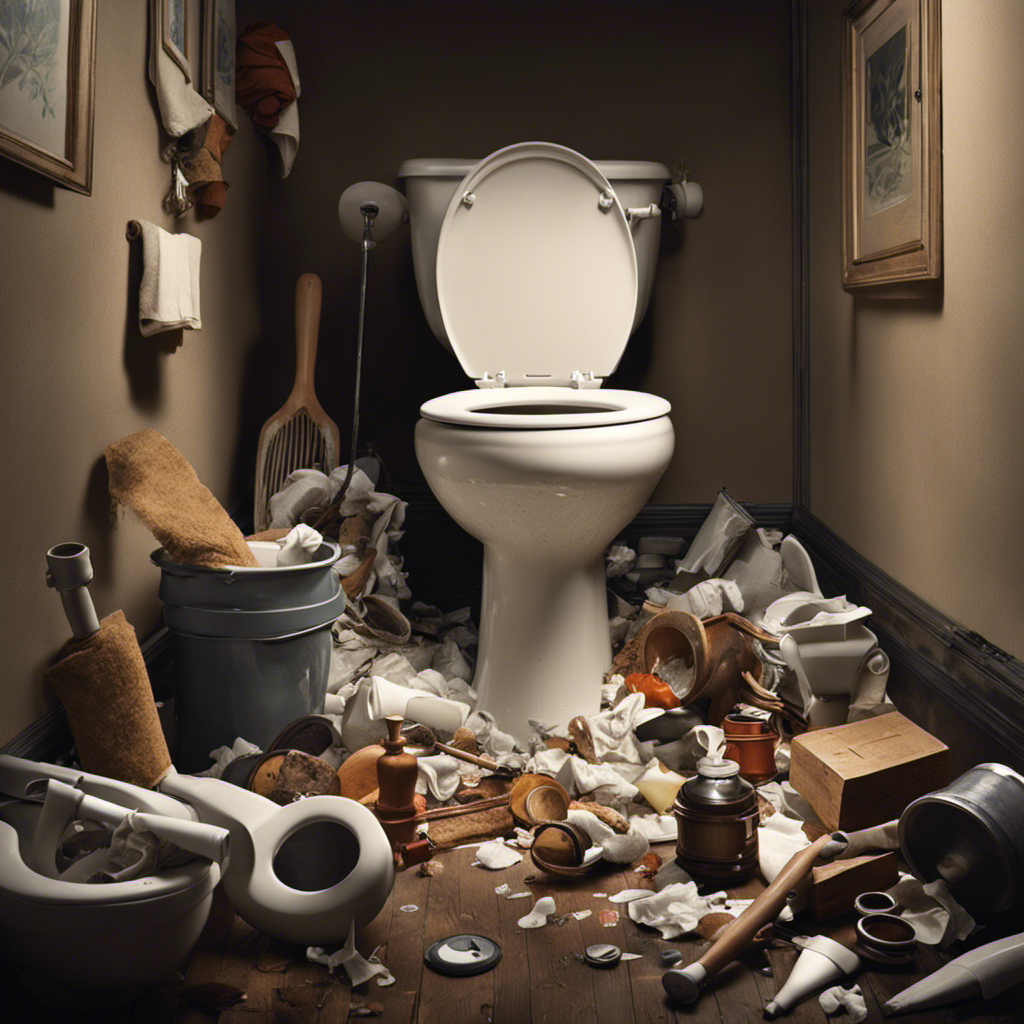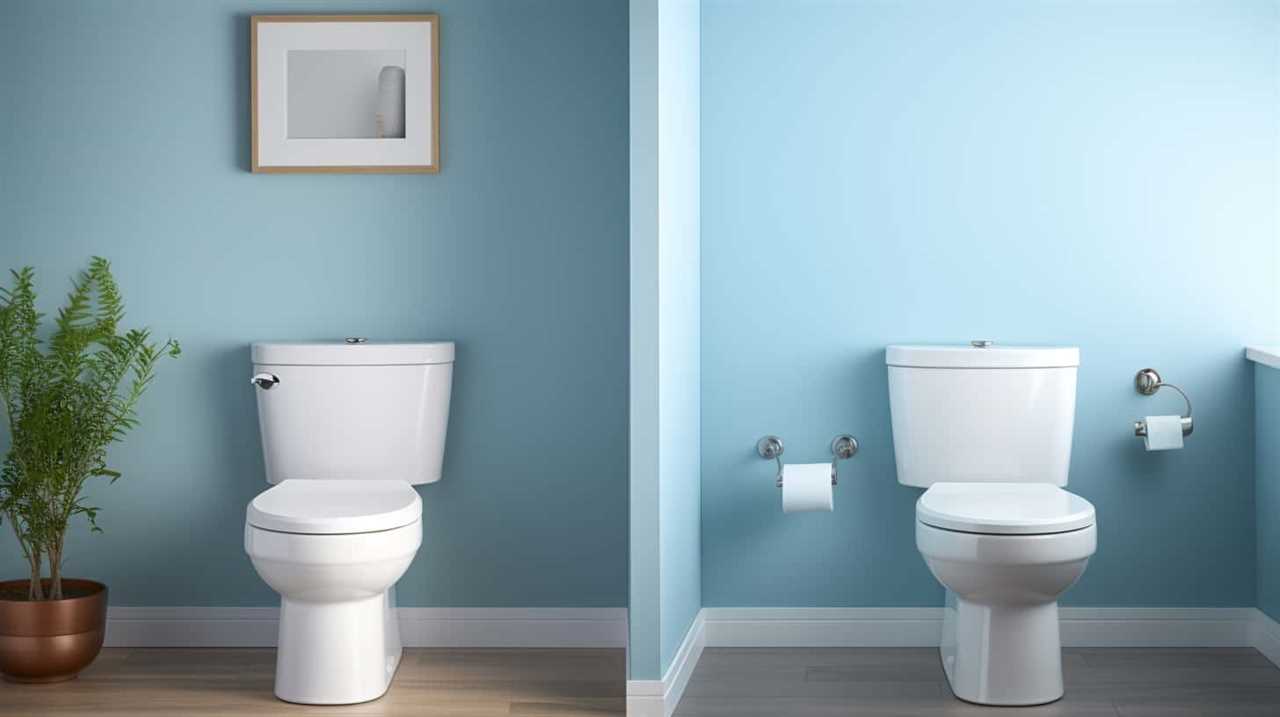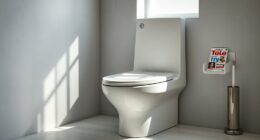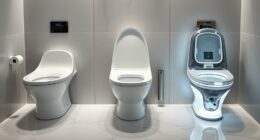I’ve been there before – standing in front of a stubbornly clogged toilet, wondering why it just won’t unclog. But fear not, because in this article, I will guide you through the common causes of toilet clogs and provide detailed steps on how to effectively use a plunger.
I’ll even share some natural remedies to try before calling a professional plumber. So, let’s dive in and unravel the mysteries of unclogging toilets together.
Key Takeaways
- Flushing excessive amounts of toilet paper or non-flushable items can cause clogs.
- Mineral buildup and tree roots can also contribute to toilet blockages.
- Regularly cleaning the toilet and educating household members about proper usage can help prevent clogs.
- If DIY methods fail or there are signs of a more serious issue, it’s best to call a professional for toilet unclogging.
Common Causes of Toilet Clogs
One common cause of toilet clogs is when you flush excessive amounts of toilet paper at once. Toilet paper is designed to dissolve easily in water, but if you flush too much of it down the toilet at once, it can cause a blockage in the pipes.
To prevent toilet clogs, it’s important to use toilet paper in moderation and flush smaller amounts at a time.
Another DIY toilet unclogging method is using a plunger. Place the plunger over the drain hole and push down firmly, then pull up quickly. The suction created by the plunger can help dislodge the blockage.
If the clog persists, you can try using a plumbing snake to physically remove the obstruction. Remember to always exercise caution and wear protective gloves when attempting these DIY methods.
How to Check for Blockages in the Toilet
To check for blockages in your toilet, start by using a plunger to see if that resolves the issue. If the plunger doesn’t work, you may have a more severe clog that requires further investigation.
Here are some steps you can take to check for blockages in your toilet:
-
Inspect the water level: If the water level is unusually high or low, it could indicate a blockage.
-
Look for signs of overflow: If water starts to overflow from the bowl or drain, it’s a clear sign of a severe toilet blockage.
-
Check the flushing mechanism: If the flushing mechanism is not working properly or if you notice weak flushes, it could be due to a blockage.
Steps for Using a Plunger Effectively
Start by positioning the plunger over the drain and creating a strong seal with the toilet bowl. This is crucial for effective unclogging.
Once the plunger is in place, push down firmly to create suction. Then, pull up quickly to create pressure and force the clog to dislodge. Repeat this plunging motion several times, ensuring that you maintain a tight seal throughout.
It’s important to use a toilet plunger specifically designed for unclogging toilets, as it has a flange that helps create a better seal. Additionally, make sure the plunger is clean and free of any debris before using it.
If the clog persists, you may need to try alternative methods or seek professional help. Remember, a toilet plunger is a versatile tool that can effectively unclog most toilets when used correctly.
Using Natural Remedies to Unclog a Toilet
When it comes to unclogging a toilet, there are several natural remedies that can be effective.
One option is to use a combination of vinegar and baking soda. This mixture creates a chemical reaction that can help break down blockages.
Another method is the hot water method, which involves pouring boiling water into the toilet bowl to dissolve the clog.
Lastly, there are plunger alternatives that can be used, such as a toilet auger or a drain snake, which can help dislodge stubborn blockages.
Vinegar and Baking Soda
Using vinegar and baking soda can be an effective method to unclog a toilet. I have personally found this technique to be quite useful when faced with a stubborn clog. Here are some reasons why you should consider using vinegar and baking soda:
- Vinegar is a natural cleaning agent that can help dissolve the clog without causing any damage to your plumbing system.
- Baking soda acts as a mild abrasive and can help break down the blockage, allowing it to be flushed away.
By combining these two ingredients, you create a powerful mixture that can tackle even the toughest clogs. It is a safer alternative to using chemical drain cleaners, which can be harmful to both you and the environment.
Now, let’s move on to another effective method for unclogging a toilet – the hot water method.
Hot Water Method
To unclog your toilet using the hot water method, simply pour a pot of hot water into the bowl. This method is effective for clearing minor clogs caused by hair or other debris.
First, boil a pot of water on the stove or use hot water from the tap. Make sure the water is not boiling, as this can crack the porcelain.
Carefully pour the hot water into the toilet bowl, aiming for the center. The hot water helps to break down any hair clogs by softening them and allowing them to flow through the pipes more easily.
Repeat this process if necessary, but be cautious not to overflow the toilet. Remember, this method is most suitable for hair clogs and may not be effective for more serious blockages.
Plunger Alternatives
The plunger alternatives can be just as effective in clearing minor toilet clogs. When faced with a stubborn clog, consider using a toilet auger or a drain snake as an alternative to the traditional plunger method.
Here are two sub-lists to help you understand their effectiveness:
-
Toilet Auger:
- A toilet auger, also known as a closet auger, is a specialized tool designed specifically for toilet clogs.
- It features a long, flexible cable with a corkscrew-like tip that can navigate through the curves of the toilet trap to dislodge the clog.
-
Drain Snake:
- A drain snake is a versatile tool that can be used for various plumbing clogs, including toilet clogs.
- It consists of a long, coiled wire with a handle on one end and a barbed or hook-like tip on the other, which helps grab onto and remove the clog.
These alternatives can be highly effective in clearing minor clogs. However, if the clog persists or if you’re unsure how to use these tools properly, it’s best to call a professional plumber for assistance. They have the expertise and specialized equipment to handle more complex clogs and avoid potential damage to your plumbing system.
When to Call a Professional Plumber
If your toilet is not unclogging despite your best efforts, it might be time to call a professional plumber. While there are many DIY methods to try, some plumbing issues require the expertise of a trained professional. Here are some signs that indicate a serious plumbing issue and when it’s best to call a plumber:
| Signs of a Serious Plumbing Issue | When to DIY or Call a Plumber |
|---|---|
| Repeated clogs | Call a plumber |
| Water backing up into other drains | Call a plumber |
| Foul odors coming from the toilet | Call a plumber |
If you notice any of these signs, it’s important not to ignore them. Repeated clogs may be a sign of a deeper plumbing problem, such as a blockage in the sewer line. Water backing up into other drains can indicate a main sewer line clog. Foul odors could indicate a problem with the toilet’s vent pipe or a blockage in the sewer system. These issues require professional attention to prevent further damage and ensure the proper functioning of your plumbing system.
Preventive Measures to Avoid Future Toilet Clogs
One way to prevent future toilet clogs is by regularly maintaining your plumbing system. By following some simple toilet maintenance tips, you can avoid the hassle of dealing with clogged toilets. Here are a few preventive measures you can take:
- Regularly clean your toilet bowl and tank to remove any buildup of mineral deposits or debris.
- Avoid flushing items that can easily clog your toilet, such as wipes, feminine hygiene products, or excessive amounts of toilet paper.
When it comes to DIY toilet unclogging methods, there are a few techniques you can try before calling a professional:
- Use a plunger to create suction and dislodge the clog.
- Use a toilet auger to break up the clog and remove it.
Frequently Asked Questions
How Do I Know if My Toilet Is Clogged?
To know if my toilet is clogged, I check for signs like water rising or not flushing properly. Unclogging it involves steps like using a plunger or a toilet auger to clear the blockage.
What Are Some Common Causes of Toilet Clogs?
To avoid toilet clogs, it’s important to understand common causes. Factors like excessive toilet paper, flushing non-flushable items, or a faulty plumbing system can lead to clogs. Proper maintenance and awareness can prevent these issues.
Can I Use a Plunger to Unclog My Toilet?
Yes, you can use a plunger to unclog your toilet. It is a common DIY method for unclogging toilets. If the plunger doesn’t work, you can also try using a snake to unclog it.
Are There Any Natural Remedies to Unclog a Toilet?
Sure, there are DIY toilet unclogging methods that involve natural remedies. Using natural remedies can be beneficial as they are often safe for the environment and can save you money on expensive plumbing services.
When Should I Call a Professional Plumber for a Clogged Toilet?
If my toilet isn’t unclogging, signs of a serious clog include repeated backups, slow draining, and gurgling sounds. Ignoring it can lead to water damage, sewage backup, and costly repairs. Call a professional plumber to avoid further issues.
Conclusion
In conclusion, unclogging a toilet can be a frustrating and messy task, but with the right knowledge and tools, it can be easily resolved. By understanding the common causes of toilet clogs and knowing how to check for blockages, you can determine the best course of action.
Using a plunger effectively and utilizing natural remedies can often do the trick. However, in more severe cases, it may be necessary to call a professional plumber for assistance. Remember to practice preventive measures, such as avoiding flushing non-flushable items, to avoid future toilet clogs.
For example, let’s consider the case of John, who recently experienced a stubborn toilet clog. After identifying a minor blockage using the techniques mentioned in this article, he decided to try using a plunger. With steady pressure and a few well-executed plunges, he successfully cleared the clog and restored the toilet’s functionality.
John’s experience highlights the effectiveness of using the right tools and techniques to resolve toilet clogs.










